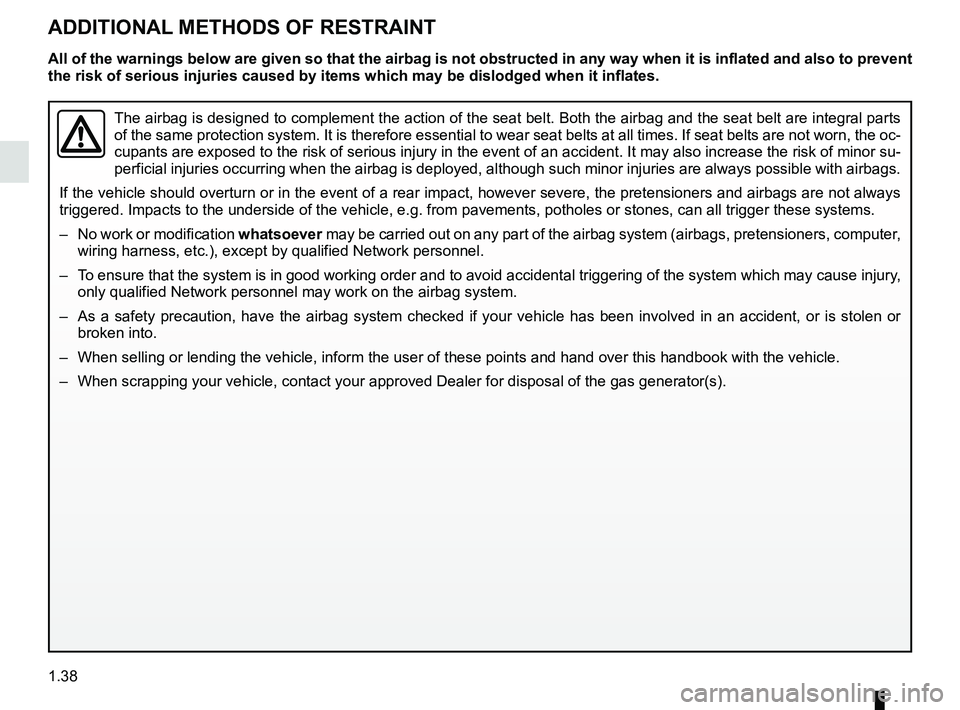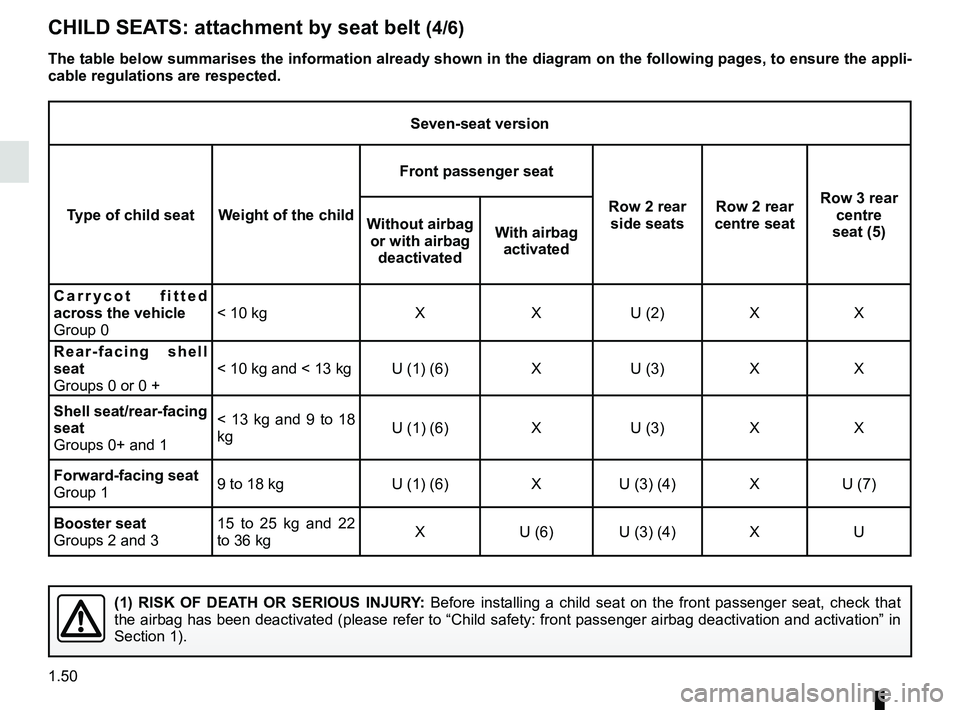Page 44 of 364

1.38
ADDITIONAL METHODS OF RESTRAINT
The airbag is designed to complement the action of the seat belt. Both t\
he airbag and the seat belt are integral parts
of the same protection system. It is therefore essential to wear seat be\
lts at all times. If seat belts are not worn, the oc-
cupants are exposed to the risk of serious injury in the event of an acc\
ident. It may also increase the risk of minor su-
perficial injuries occurring when the airbag is deployed, although such \
minor injuries are always possible with airbags.
If the vehicle should overturn or in the event of a rear impact, however\
severe, the pretensioners and airbags are not always
triggered. Impacts to the underside of the vehicle, e.g. from pavements,\
potholes or stones, can all trigger these systems.
– No work or modification whatsoever may be carried out on any part of the airbag system (airbags, pretensi\
oners, computer,
wiring harness, etc.), except by qualified Network personnel.
– To ensure that the system is in good working order and to avoid accidenta\
l triggering of the system which may cause injury, only qualified Network personnel may work on the airbag system.
– As a safety precaution, have the airbag system checked if your vehicle h\
as been involved in an accident, or is stolen or broken into.
– When selling or lending the vehicle, inform the user of these points and\
hand over this handbook with the vehicle.
– When scrapping your vehicle, contact your approved Dealer for disposal o\
f the gas generator(s).
All of the warnings below are given so that the airbag is not obstructed in any way when it is inflated and also to prevent
the risk of serious injuries caused by items which may be dislodged when\
it inflates.
Page 51 of 364

1.45
CHILD SAFETY: fitting a child seat, general information (1/2)
The types of child seats indicated may
not be available. Before using a differ-
ent child seat, check with the manufac-
turer that it can be fitted.
In the front seat
The laws concerning children travel-
ling in the front passenger seat differ in
every country. Consult the legislation in
force and follow the indications on the
diagram on the following page.
Before fitting a child seat in this seat (if
authorised):
– lower the seat belt as far as possible;
– move the seat as far back as possi-ble;
– gently tilt the seatback away from vertical (approximately 25°);
– on equipped vehicles, raise the seat base as far as possible.
In all situations, reinsert the headrest to
its full extent so that it does not interfere
with the child seat (see the information
on “Front headrests” in Section 1);
Some seats are not suitable for fitting
child seats. The diagram on the follow-
ing page shows you how to attach a
child seat.
Fit the child seat in a rear
seat wherever possible.
Make sure that the child
seat or the child’s feet do
not prevent the front seat from lock-
ing correctly. Refer to the informa-
tion on the “Front seat” in Section 1.
Check that when installing the child
seat in the vehicle it is not at risk of
coming loose from its base.
If you have to remove the headrest,
check that it is correctly stored so
that it does not come loose under
harsh braking or impact.
Always attach the child seat to the
vehicle even if it is not in use so that
it does not come loose under harsh
braking or impact.
RISK OF DEATH OR
SERIOUS INJURY: before
fitting a rear-facing child
seat to this seat, check
that the airbag has been deacti-
vated (refer to the information on
“Child safety: deactivating/activat-
ing the front passenger airbag” in
Section 1).
After installing the child seat, when this
is possible, you can move the vehi-
cle seat forward if necessary (so as to
leave enough space in the rear seats
for passengers or other child seats). In
the case of a rear-facing child seat, do
not let it touch the dashboard or move it
to the furthest forward position.
Do not change other settings after in-
stalling the child seat.
Page 53 of 364
1.47
CHILD SEATS: attachment by seat belt (1/6)
Visual installation of the five-seater version
RISK OF DEATH OR
SERIOUS INJURY: before
installing a rear-facing child
seat in the front passen-
ger seat, make sure the airbag has
been deactivated (refer to the infor-
mation on “Child safety: front pas-
senger airbag deactivation/activa-
tion” in Section 1).
Using a child safety system
which is not approved for
this vehicle will not correctly
protect the baby or child.
They risk serious or even fatal injury.
³ Check the status of the airbag
before fitting a child seat or allowing a
passenger to use the seat.
²Seat not suitable for fitting
child seats.
¬ Seat which allows a child seat
with “Universal” approval to be attached
by a seat belt.
Page 54 of 364
1.48
CHILD SEATS: attachment by seat belt (2/6)
Five-seater version
Type of child seat Weight of
the child Front passenger seat
Rear side seats Rear centre seat
Without airbag
or with airbag
deactivated With
airbag
activated
Carrycot fitted
across the vehicle
Group 0 < 10 kg X X U (2) X
Rear-facing shell
seat
Groups 0 or 0 + < 10 kg and
< 13 kg
U (1) (5) X U (3) X
Shell seat/rear-facing
seat
Groups 0+ and 1 < 13 kg and 9 to
18 kg
U (1) (5) X U (3) X
Forward-facing seat
Group 1 9 to 18 kg U (1) (5) X U (3) (4) X
Booster seat
Groups 2 and 3 15 to 25 kg and
22 to 36 kg
X U (5) U (3) (4) X
(1) RISK OF DEATH OR SERIOUS INJURY: Before installing a child seat on the front passenger seat, check that \
the airbag has been deactivated (please refer to “Child safety: fron\
t passenger airbag deactivation and activation” in
Section 1).
The table below summarises the information already shown on the diagram \
on the previous page, to ensure the applica-
ble regulations are respected.
Page 56 of 364

1.50
CHILD SEATS: attachment by seat belt (4/6)
Seven-seat version
Type of child seat Weight of the child Front passenger seat
Row 2 rear side seats Row 2 rear
centre seat Row 3 rear
centre
seat (5)
Without
airbag
or with airbag
deactivated With
airbag
activated
Carrycot fitted
across the vehicle
Group 0 < 10 kg X X U (2) X X
Rear-facing shell
seat
Groups 0 or 0 + < 10 kg and < 13 kg U (1) (6) X U (3) X X
Shell seat/rear-facing
seat
Groups 0+ and 1 < 13 kg and 9 to 18
kg
U (1) (6) X U (3) X X
Forward-facing seat
Group 1 9 to 18 kg U (1) (6) X U (3) (4) X U (7)
Booster seat
Groups 2 and 3 15 to 25 kg and 22
to 36 kg
X U (6) U (3) (4) X U
(1) RISK OF DEATH OR SERIOUS INJURY: Before installing a child seat on the front passenger seat, check that \
the airbag has been deactivated (please refer to “Child safety: fron\
t passenger airbag deactivation and activation” in
Section 1).
The table below summarises the information already shown in the diagram \
on the following pages, to ensure the appli-
cable regulations are respected.
Page 58 of 364
1.52
³ Check the status of the airbag
before fitting a child seat or allowing a
passenger to use the seat.
²Seat not suitable for fitting
child seats.
¬ Seat which allows a child seat
with “Universal” approval to be attached
by a seat belt.
Using a child safety system
which is not approved for
this vehicle will not correctly
protect the baby or child.
They risk serious or even fatal injury.
RISK OF DEATH OR
SERIOUS INJURY: before
installing a rear-facing child
seat in the front passen-
ger seat, make sure the airbag has
been deactivated (refer to the infor-
mation on “Child safety: front pas-
senger airbag deactivation/activa-
tion” in Section 1).
CHILD SEATS: attachment by seat belt (6/6)
Installation diagram, 7-seater version
Page 59 of 364
1.53
CHILD SEATS: attachment using the ISOFIX system (1/6)
Seat which allows an ISOFIX
child seat to be fitted.
± The rear seats are fitted with
an anchorage point which allows a
forward-facing ISOFIX child seat with
universal approval to be attached. The
anchorage points are located on the
backs of the rear seats.
Using a child safety system
which is not approved for
this vehicle will not correctly
protect the baby or child.
They risk serious or even fatal injury.
²Seat which does not allow a
child seat to be fitted.
Visual installation of the five-seater version
RISK OF DEATH OR
SERIOUS INJURY: before
installing a rear-facing child
seat in the front passen-
ger seat, make sure the airbag has
been deactivated (refer to the infor-
mation on “Child safety: front pas-
senger airbag deactivation/activa-
tion” in Section 1).
Page 60 of 364
1.54
CHILD SEATS: attachment using the ISOFIX system (2/6)
Five-seater version
Type of child seat Weight of
the child Seat size
ISOFIX Front passenger seat
Rear side seats Rear centre
seat
Without
airbag
or with airbag
deactivated With
airbag
activated
Carrycot fitted across
the vehicle
Group 0 < 10 kg
F, GXXXX
Rear-facing shell
seat
Groups 0 or 0 + < 10 kg and
< 13 kg
E
IL (1) (4) XIL (2) X
Shell seat/rear-facing
seat
Groups 0+ and 1 < 13 kg and 9
to 18 kg
C, D
IL (1) (4) XIL (2) X
Forward-facing seat
Group 1 9 to 18 kg A, B, B1 IUF - IL (1) (4) X IUF - IL
(2) (3) X
Booster seat
Groups 2 and 3 15 to 25 kg
and 22 to 36
kg
X IUF - IL (1)
IUF - IL
(2) (3) X
Seat i-Size i-U (1) (4)Xi-U X
The table below summarises the information already shown on the diagram \
on the previous page, to ensure the regula-
tions in force are respected.